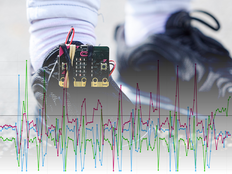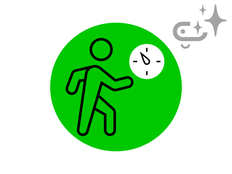第 1 步:制作
它是什么?
将您的BBC micro:bit变成一个步数计(或计步器),以帮助你跟踪自己的活动量——并同时学习一些编程!
这两个视频介绍了你将制作什么以及如何编程:
介绍
编程指南
工作原理
- 将代码下载到micro:bit上,并连上一个电池组。
- 将您的micro:bit和电池组附着在鞋子或脚踝上,或者放在袜子里面,又或者只是手持并在走路时摇动它。
- 这个代码使用micro:bit的加速计感应器的输入,来感知您正在运动。
- 这段代码计算micro:bit被晃动了多少次。 它将这个次数存放在一个名为steps的 变量 里。
- 变量是存放数据的容器,在程序的运行过程中,变量里的数据可以被读取或改写。
- 每当micro:bit的加速计感应到了晃动,程序会将变量里保存的的数字加一,然后在LED显示屏显示最新的数字。
所需材料
- micro:bit或者是MakeCode模拟器
- MakeCode 或者 Python 编辑器
- 电池盒
- 将micro:bit固定在鞋子或腿上的东西,例如绳子、胶带或魔术贴。
第 2 步:编程
第3步:完善
- 修改代码,使得您按下一个按钮时能显示当前步数。
- 如果您发现代码每隔一步才计数一次(比如说micro:bit被绑在了左腿,走路的时候就少算了右腿的一步),修改代码,在显示‘steps’变量时将其乘以二。
- 测量您平均步幅的长度,并让您的micro:bi将步幅t乘以步数来算出您走过的距离。

This content is published under a Creative Commons Attribution-ShareAlike 4.0 International (CC BY-SA 4.0) licence.


